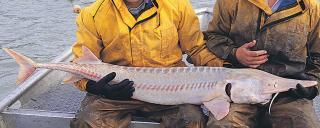
Pallid Sturgeon
| Scientific Name | Scaphirhynchus albus |
|---|---|
| General Description | Grows up to seven feet in length. Light gray in color with a lighter underside. Small black eyes set on a large shovel-shaped head. Four barbels on the underside of the head with the two inner barbels shorter than the outer two. This distinguishes it from the more common shovelnose sturgeon. The top side of its body is covered in large scales called scutes. |
| Status | Year-round resident. Abundance: Rare. |
| Abundance | Rare. |
| Primary Habitat | Only found in the Missouri River and parts of the Yellowstone River. Usually in fast current areas with a firm sand or gravel bottom. |
| Federal Status | Endangered. |
| Reason for Designation | Loss of river habitat due to channelization and impoundment has caused declines in this species within the state and range wide. Dams have also fragmented populations. |
Locations and Conditions of Key Habitat
Preferred Habitat
Pallid Sturgeon are well adapted for life on the bottom of a fast flowing, turbid river. Generally found in stretches of river with 40 to 90 cubic feet per second velocity. Areas at the end of chutes or sandbars are commonly used, most likely for energy conservation and feeding. The range of depths used varies seasonally, with most fish being found shallow in the spring and deeper in the fall.
Key Areas and Conditions for Pallid Sturgeon in North Dakota
Pallid Sturgeons are most commonly found in the upper Missouri River upstream of Lake Sakakawea, and in the Yellowstone River near the confluence of the two rivers.
Problems Which May Affect this Species
Habitat
Destruction and alteration of habitats by human modification of the river system is likely the primary cause of declines in reproduction, growth, and survival of Pallid Sturgeon (USFWS 1993). Much of the species’ habitat was destroyed when a number of large dams were constructed on the Missouri River, producing a number of large reservoirs. These structures changed the velocity, volume and timing of flows in the river from pre-impoundment. In the system much of the remaining river has been channelized. This has changed the velocity, reduced the width of the river, and prevented water flow into backwater areas important to this species (USFWS 1993).
Other Natural or Manmade Factors
The ACOE manages water releases from impoundments in the Missouri River System. Flows are generally reduced in the spring and then increased later in the summer. This is the opposite of preimpoundment when high flows were common in spring and then decreased throughout the year. This has impacted reproduction, larval fish rearing, and food supplies (USFWS 1993).
Research and Survey Efforts
Current Research or Surveys
- Currently the USFWS tracks a number of fish with radio transmitters. Habitat use, seasonal movement and other information is obtained.
- Captive breeding and rearing of Pallid Sturgeon at Garrison Dam National Fish Hatchery.
Previous Research or Surveys
- A status review and recovery plan has been conducted and developed by the USFWS.
Additional Research or Surveys Needed
No additional research and survey efforts have been identified.
Management Recommendations
- Protect rivers, streams, and riparian areas where possible (i.e. easements and/or acquisition).
- Work with partners to ensure Swampbuster provisions are maintained.
- Continue to use the Section 404 program to ensure affected rivers and riparian areas are mitigated to replace form and function.
- Continue to work with other federal agencies (i.e. FAA and FHWA) not covered by Section 404 or Swampbuster to ensure affected rivers and riparian areas are mitigated to replace form and function.
- Continue to work with NDSWC to develop minimum in-stream flow recommendations.
- Develop and promote incentive programs to restore riparian areas.
- Continue to work with ND 319 Task Force in prioritizing projects within impaired watersheds and implementing BMP’s.
- Develop and promote incentive programs for adjacent landowners to improve bank stability through land use changes (e.g. RRBRP).
- Promote non-traditional bank stabilization measures (i.e. root wads, willow waddles, vegetative slope).
- Implement intake conditions or recommendations (i.e. screening and velocity requirements).
- Work with the dam owners for potential removal or modification.
- Cooperate with Fisheries Division on state aquatic nuisance species plan.
- Survey areas of data gaps. Conduct research/surveys to establish baseline information on SCP.
- Continue to work with partners in promoting and distributing educational materials related to river, stream and riparian values and good stewardship.
Monitoring Plans
USFWS, USGS, and Montana FWP conduct population surveys of the Pallid Sturgeon in the Yellowstone River and Williston reach of the Missouri River.
2005-2015 Progress
The Pallid Sturgeon maintains its Level II Species of Conservation Priority. Much is known about the status of this species within the state. As part of a recovery plan pallids are captive bred to be released in to the Missouri River system. Known individuals are tracked throughout the year.

Note: A listing of works consulted when compiling the information on this page may be found in the 2015 State Wildlife Action Plan.
